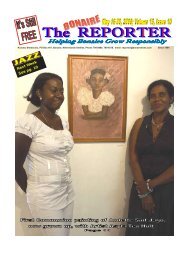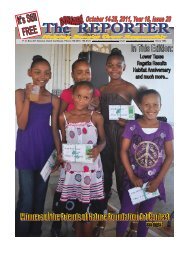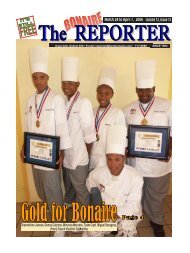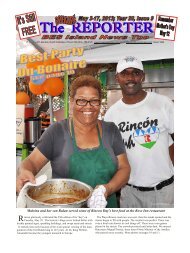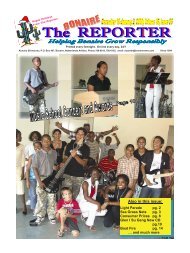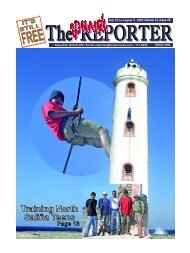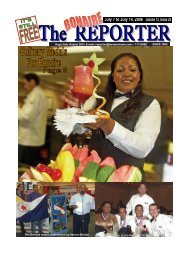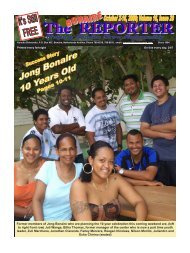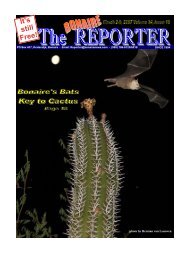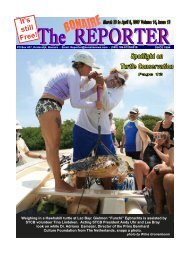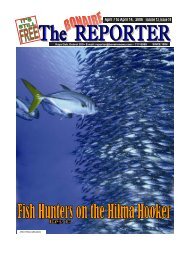Birth Countries of Bonaire's Legal Residents - The Bonaire Reporter
Birth Countries of Bonaire's Legal Residents - The Bonaire Reporter
Birth Countries of Bonaire's Legal Residents - The Bonaire Reporter
You also want an ePaper? Increase the reach of your titles
YUMPU automatically turns print PDFs into web optimized ePapers that Google loves.
photo:/www.portpromotions.com/upload/1216740817_Stingray.jpg<br />
Did You Know...<br />
T hat stingrays feel<br />
stress? <strong>The</strong> effects <strong>of</strong> ecotourism<br />
on animal stress levels have been<br />
well-studied for many marine animals,<br />
including dolphins, turtles, and seabirds,<br />
but researchers have only recently learned<br />
that ecotourism can negatively affect the<br />
health <strong>of</strong> stingrays. At stingray ecotourism<br />
hotspots, boat charters and cruise ships<br />
<strong>of</strong>fer visitors the opportunity to observe<br />
and stroke stingrays by enticing the animals<br />
to within touching distance using<br />
pieces <strong>of</strong> squid and fish.<br />
To investigate what effect all <strong>of</strong> this<br />
touching, feeding, and boating has on the<br />
health <strong>of</strong> the stingrays, a team <strong>of</strong> researchers<br />
compared blood samples collected from<br />
southern stingrays (Dasyatis americana)<br />
present at a popular stingray tourism site in<br />
Grand Cayman to samples from rays not<br />
exposed to tourism (Semenuik et al, 2009).<br />
Blood tests revealed that stingrays exposed<br />
to tourists had weaker immune systems<br />
than rays that did not interact with tourists.<br />
A compromised immune system might<br />
make them more vulnerable to disease or<br />
parasitic infections. Stingrays with injuries<br />
caused by boats were also frequently seen<br />
in this study. Although common sense<br />
would suggest that stressed-out stingrays<br />
would simply avoid areas with intense<br />
tourist activity, the high availability <strong>of</strong><br />
food at these ecotourism sites likely motivates<br />
some rays to use these areas in spite<br />
<strong>of</strong> the added stress. Currently, there are no<br />
regulations on the stingray ecotourism industry,<br />
but new legislation was recently<br />
introduced in the Cayman Islands to better<br />
protect marine wildlife from stresses related<br />
to ecotourism.<br />
While not all interactions that marine<br />
animals have with people are stressful, it is<br />
important to remember that animals need<br />
<strong>Bonaire</strong> <strong>Reporter</strong>- September 18,-October 2, 2009<br />
their “personal space” and can become ill<br />
if fed foods that are not a part <strong>of</strong> their natural<br />
diet. Rays are not abundant in <strong>Bonaire</strong><br />
compared to other areas <strong>of</strong> the Caribbean,<br />
but whenever you are fortunate enough to<br />
see a spotted eagle ray gliding over a reef,<br />
remember – shark and ray populations are<br />
under tremendous pressure from overfishing,<br />
habitat loss, and ecotourism – and<br />
without effective conservation measures,<br />
the opportunities we have to see these<br />
graceful animals may become increasingly<br />
rare. Kate Jirik<br />
Author Kate Jirik (above) recently completed<br />
her graduate studies on the habitat<br />
use <strong>of</strong> stingrays and sea turtles in southern<br />
California, U.S.A. She is currently teaching<br />
and conducting research at CIEE Research<br />
Station <strong>Bonaire</strong><br />
(www.cieebonaire.org).<br />
References and further reading may be available for<br />
this article. To view references and further reading<br />
you must purchase this article from Science Direct.<br />
http://www.sciencedirect.com/science?<br />
_ob=ArticleURL&_udi=B6V5X-4W4S374-<br />
2&_user=10&_coverDate=08%2F31%<br />
2F2009&_rdoc=1&_fmt=full&_orig=search&_cdi=5<br />
798&_sort=d&_docanchor=&view=c&_searchStrId=<br />
1009861962&_rerunOrigin=google&_acct=C000050<br />
221&_version=1&_urlVersion=0&_userid=10&md5<br />
=3459f15ffbecc41c75669fa5feb988b6<br />
C.A.D. Semeniuk, S. Bourgeon, S. L. Smith and K.<br />
D. Rothley. 2009. Hematological differences between<br />
stingrays at tourist and non-visited sites suggest<br />
physiological costs <strong>of</strong> wildlife tourism. Biol. Cons.<br />
142(8):1818-1829.<br />
Question (from page 7):<br />
What is the name <strong>of</strong> the <strong>Bonaire</strong> keystone species?<br />
Answer: <strong>The</strong> Bat<br />
e pampered for break- B fast or lunch by<br />
youngsters in training for<br />
the world <strong>of</strong> the<br />
pr<strong>of</strong>essional restaurant<br />
business by the Stichting<br />
Project. Delicious menu,<br />
Good prices<br />
On Kaya Gob. N. Debrot –<br />
opposite the Divi Flamingo<br />
Hotel<br />
Open: Weekdays<br />
9.00-14.00<br />
Drinking Cacatus necter<br />
MAKING YOUR SPACE<br />
A BETTER PLACE<br />
USA LICENSED CONTRACTOR /<br />
30 YEARS WORLDWIDE<br />
CONSTRUCTION EXPERIENCE<br />
HOURLY RATES – 7 DAYS<br />
INSTALLATIONS – REPAIRS – REMODELS<br />
HOTELS RESTAURANTS <br />
RESIDENTIAL<br />
TELE 717 -3527 - FAX 717-3528 -<br />
CELL 701-3527<br />
EMAIL: EQUINOXBONAIRE@AOL.COM<br />
BONAIRE VENTURES B.V.<br />
On time Done Right<br />
Page 15



